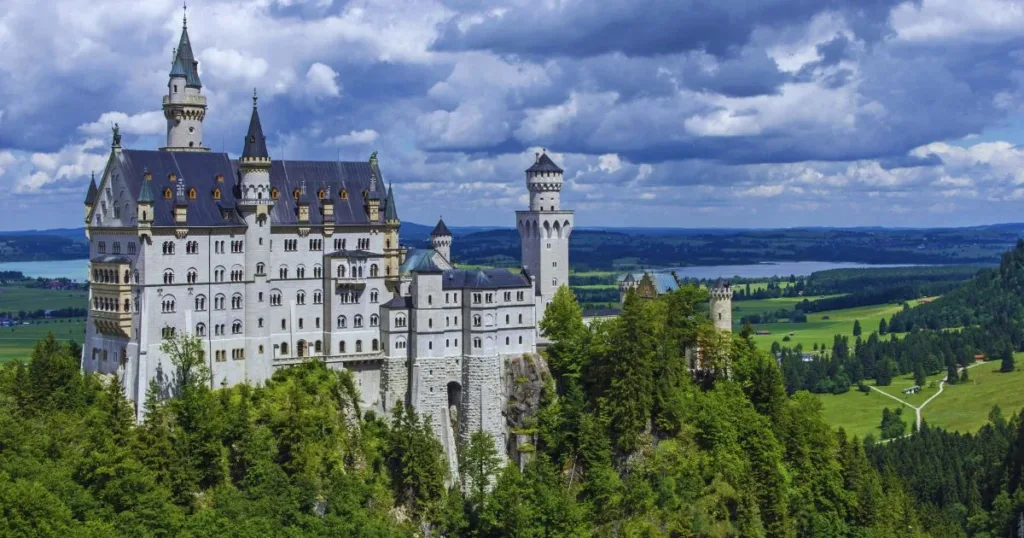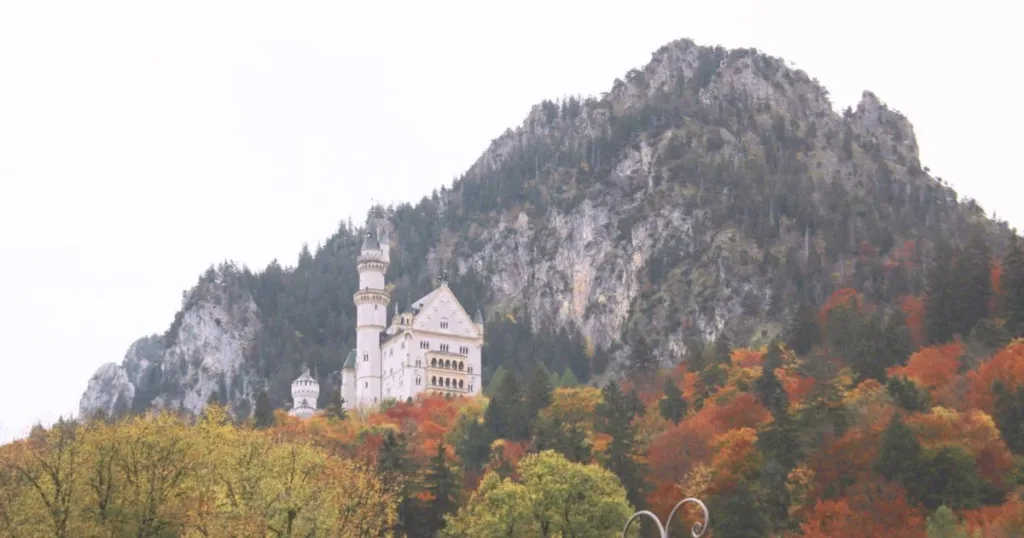Inside Neuschwanstein Castle, one of Europe’s most iconic landmarks, stands proudly in the Bavarian Alps of southern Germany, captivating millions of visitors every year. Known for its stunning beauty and its role as inspiration for Disney’s Sleeping Beauty Castle, Neuschwanstein is more than just a fairy tale setting—it’s filled with fascinating stories and hidden details that will surprise even the most seasoned traveler. If you’ve ever wondered what lies inside Neuschwanstein Castle, here are 10 hidden stories that will captivate every traveler.
Neuschwanstein Castle 10 Untold Stories
The Mysterious King Ludwig II

The story of King Ludwig II, who commissioned Neuschwanstein Castle, is filled with intrigue and mystery. Often referred to as the “Fairy Tale King,” Ludwig’s eccentricities are a source of fascination. He built the castle as an homage to Richard Wagner, his favorite composer, and it remains unfinished to this day, leaving many wondering why. Was he inspired by visions, or was he perhaps running away from reality? King Ludwig’s strange life and mysterious death continue to fuel rumors, adding an air of mystery to the castle.
Inside Neuschwanstein Castle, you’ll learn more about this enigmatic king who had grand ideas but faced political challenges that contributed to his tragic demise.
A Castle Inspired by Wagner’s Operas

Neuschwanstein Castle is a tribute to the operas of Richard Wagner, especially Lohengrin and Tristan und Isolde. Throughout the castle, you’ll find references to Wagner’s characters and themes, from the Swan Knight motif (the basis of Lohengrin) to scenes from Wagner’s other operas, which are beautifully depicted in the murals.
The “Wagner Room” inside the castle is dedicated entirely to Wagner’s work and is a must-see for opera lovers. The deeper you venture into the castle, the more you discover how deeply Ludwig’s love for Wagner permeated every inch of the castle’s design.
Hidden Rooms and Secret Staircases

Neuschwanstein Castle is famous for its fairy-tale appearance, but inside, it has its share of hidden features. There are several secret staircases and rooms, many of which were never finished. Some of these passages were originally designed to allow the king to travel discreetly through the castle, away from the prying eyes of his advisors.
While many of these areas remain closed to the public, there are still a few accessible spots that give you a glimpse into the castle’s secretive nature. These hidden details add an air of mystery to your visit, making the experience even more thrilling.
The Unfinished Rooms
One of the most intriguing aspects of Inside Neuschwanstein Castle is the number of rooms that were never completed. King Ludwig II’s untimely death in 1886 left the castle in a state of semi-completion, and today, parts of it are still bare and unadorned. For example, the Throne Room was intended to be a grand hall fit for a king, but it lacks a throne and remains unfinished.
These unfinished rooms serve as a stark reminder of Ludwig’s tragic fate and contribute to the castle’s hauntingly beautiful atmosphere.
The Swan Symbolism

The swan is one of the most prominent symbols inside Neuschwanstein Castle. The king’s love for swans is reflected in the castle’s design, as well as in the swan-shaped motifs throughout the building. Swans were an important part of Ludwig II’s personal symbolism and were even featured in his coat of arms.
In the castle, swan references appear in the Swan Knight Room, the throne room, and throughout the surrounding grounds. The swan is a symbol of purity, and Ludwig’s obsession with it adds to the ethereal quality of the castle.
The Enchanted Stables

While most visitors focus on the grandeur of the castle itself, the royal stables are a hidden gem that shouldn’t be missed. Situated behind the castle, the stables were designed with the same attention to detail as the castle. They are home to intricate designs and carvings, and the stables have their own story to tell.
Ludwig II originally wanted to use the stables to house his royal horses, but they were never fully utilized due to the king’s untimely death. The building is now part of the castle complex and showcases the king’s interest in grandeur and beauty in every aspect of his life.
The King’s Private Chapel

Inside Neuschwanstein Castle, you’ll find King Ludwig II’s private chapel, a serene space where the king would go to pray and find solace. The chapel is simple yet elegant, and it’s one of the few rooms in the castle that feels more grounded in reality than fantasy.
The chapel’s peaceful atmosphere provides a stark contrast to the extravagance of the rest of the castle. It’s a quiet moment of reflection amid the fairy-tale-like splendor of Neuschwanstein.
The Views That Inspired the Castle’s Location

One of the most breathtaking features of Neuschwanstein Castle is its location. Perched on a rocky hilltop overlooking the picturesque Hohenschwangau Valley, the castle offers sweeping views of the surrounding landscape. Ludwig chose this location because of its natural beauty and its proximity to his childhood home, Hohenschwangau Castle.
Inside Neuschwanstein Castle, the windows frame some of the most iconic views in all of Europe. Visitors are encouraged to take in the scenery and appreciate the natural beauty that inspired Ludwig to build his fairy-tale castle in the first place.
The King’s Obsession with Privacy
King Ludwig II was known for his intense desire for privacy, and this is reflected in the design of Neuschwanstein Castle. Throughout the building, you’ll find hidden passageways and secret doors that allowed Ludwig to move freely throughout the castle without being seen. These secret routes also helped the king avoid the heavy political pressure he faced as monarch.
The king’s obsession with privacy is also evident in his limited contact with the outside world, particularly towards the end of his life. This hidden side of Ludwig’s personality adds an intriguing layer to your visit to the castle.
The Castle’s Fascinating Architecture

Inside Neuschwanstein Castle, the architecture is a mix of Gothic, Romanesque, and Renaissance Revival styles. The interior is just as spectacular as the exterior, with rooms designed to evoke the feeling of a medieval castle. The Throne Room, with its Byzantine-inspired decorations, and the Singer’s Hall, inspired by the tales of Wagner’s operas, are particularly striking.
The entire structure is a perfect blend of fantasy and historical architecture, and as you explore, you’ll be captivated by the way the design reflects King Ludwig II’s imaginative mind.
https://www.veenaworld.com/blog/neuschwanstein-castle
Key Features Inside Neuschwanstein Castle
| Feature | Significance | Must-See |
| King Ludwig II’s private chapel | A peaceful, personal space for reflection | The chapel’s simplicity amidst the grandeur |
| Unfinished rooms | Reminders of the king’s untimely death | The incomplete throne room and other rooms |
| The swan symbolism | Represents purity and Ludwig’s personal connection | Swan motifs throughout the castle |
| Wagner-inspired murals | Depict scenes from Wagner’s operas | The Wagner Room and its operatic representations |
| Secret staircases and rooms | Hidden passageways for privacy | Exclusive glimpses into the castle’s secret areas |
| The royal stables | Elaborate and beautifully designed stable area | The intricate carvings and royal horse stables |
| Panoramic views | Breathtaking views of the Bavarian Alps and valleys | The picturesque Hohenschwangau Valley from windows |
FAQs
Q1. Can you visit Inside Neuschwanstein Castle year-round?
Yes, Inside Neuschwanstein Castle is open year-round, though it’s most popular during the warmer months. Winter visits can offer a magical atmosphere with fewer crowds.
Q2. How long does a tour of Inside Neuschwanstein Castle take?
A guided tour of Inside Neuschwanstein Castle typically takes around 30 to 45 minutes, but you should plan for at least 2-3 hours to explore the grounds and enjoy the surrounding views.
Q3. Is Neuschwanstein Castle wheelchair accessible?
Due to the castle’s steep location, it is not fully wheelchair accessible. However, there are options for people with mobility challenges, such as horse-drawn carriage rides to the castle entrance.
Q4. What’s the best time to visit Inside Neuschwanstein Castle?
The best time to visit is in late spring to early fall when the weather is pleasant, and the surrounding scenery is at its most vibrant. However, winter offers a magical, snow-covered view.
Conclusion
Inside Neuschwanstein Castle, the stories of mystery, romance, and tragedy are as rich and captivating as its stunning architecture. From King Ludwig II’s private obsessions to the swan motifs and Wagner-inspired rooms, every corner of this fairy-tale castle tells a story. Whether you’re drawn to its architectural beauty or the fascinating life of the king who built it, Neuschwanstein Castle offers a journey through history and legend that every traveler should experience.
Check out these additional articles on our blog!
https://epictraveldiaries.com/barcelona-cathedral-5-fascinating-facts-you/




